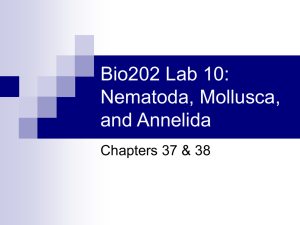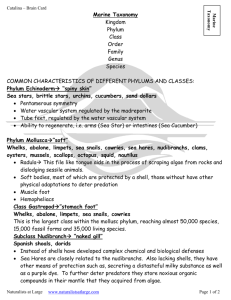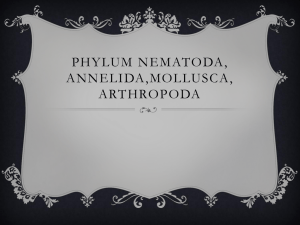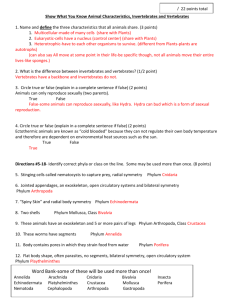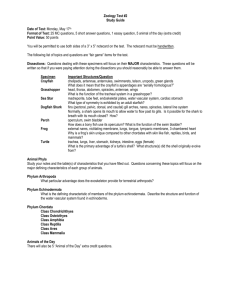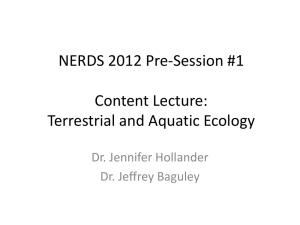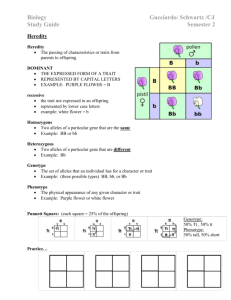Protostomes II - Orange Coast College
advertisement
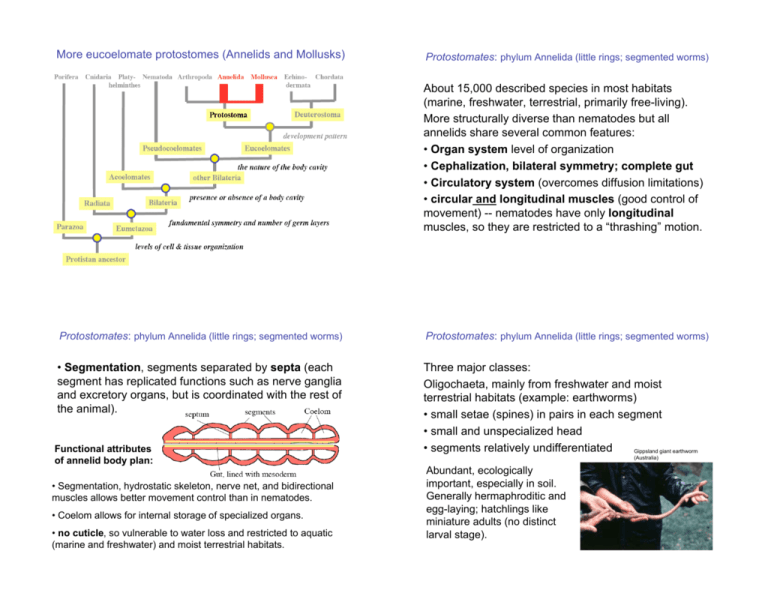
More eucoelomate protostomes (Annelids and Mollusks) Protostomates: phylum Annelida (little rings; segmented worms) About 15,000 described species in most habitats (marine, freshwater, terrestrial, primarily free-living). More structurally diverse than nematodes but all annelids share several common features: • Organ system level of organization • Cephalization, bilateral symmetry; complete gut • Circulatory system (overcomes diffusion limitations) • circular and longitudinal muscles (good control of movement) -- nematodes have only longitudinal muscles, so they are restricted to a “thrashing” motion. Protostomates: phylum Annelida (little rings; segmented worms) Protostomates: phylum Annelida (little rings; segmented worms) • Segmentation, segments separated by septa (each segment has replicated functions such as nerve ganglia and excretory organs, but is coordinated with the rest of the animal). Three major classes: Oligochaeta, mainly from freshwater and moist terrestrial habitats (example: earthworms) • small setae (spines) in pairs in each segment • small and unspecialized head • segments relatively undifferentiated Gippsland giant earthworm Functional attributes of annelid body plan: • Segmentation, hydrostatic skeleton, nerve net, and bidirectional muscles allows better movement control than in nematodes. • Coelom allows for internal storage of specialized organs. • no cuticle, so vulnerable to water loss and restricted to aquatic (marine and freshwater) and moist terrestrial habitats. (Australia) Abundant, ecologically important, especially in soil. Generally hermaphroditic and egg-laying; hatchlings like miniature adults (no distinct larval stage). Protostomates: phylum Annelida (little rings; segmented worms) Protostomates: phylum Annelida (little rings; segmented worms) Three major classes: Polychaeta, mainly from marine habitats; very diverse structurally • well-developed head, often with elaborate feeding organs or tentacles. • parapodia (fleshy flaps or extensions) on each segment, as well as setae -- spines, often large (top view): Three major classes: Polychaeta • Generally sexual • larval stage (trocophore or trocosphere) is characteristic. Trocophore is very different from adult; generally planktonic. Ecologically diverse: scavengers, predators, filter-feeders; some planktonic as adults, others live in permanent burrows, others actively crawl around, and others swim. Parapodia function in locomotion (swimming, crawling, burrowing) and for gas exchange (as gills; large surface area) Protostomates: phylum Annelida (little rings; segmented worms) Head of the marine polychaete Nereis showing feeding organs, including ‘jaws’ than be be flipped out to snatch prey. Paraposia are also visible Protostomates: phylum Annelida (little rings; segmented worms) Three major classes: Hirudinea (leeches), mainly from freshwater and moist terrestrial habitats. Highly modified (probably derived from oligochaetes): • body flattened (but can expand hugely to hold a large meal) • no setae or parapodia • segmentation reduced (and undifferentiated) • coelom largely filled with mesenchyme Different locomotion from other annelids: suckers (modified segments) at both ends of body used in an “inchworm” crawling pattern (some do swim well, however). Protostomates: phylum Annelida (little rings; segmented worms) Three major classes: Hirudinea (leeches) Predators (on small invertebrates, usually), scavengers, or parasites -- often on blood of vertebrates (cutting “teeth” and effective anesthetics and anticoagulants in saliva; very large capacity for blood). Still used medically (in fact, undergoing such a revival for microsurgery etc. that several companies sell them and some leech populations are endangered!) Protostomates: phylum Mollusca Main features of the mollusk body plan: Protostomates: phylum Mollusca Mollusks and arthropods are the two most structurally complex protostomate phyla (they are also extremely successful). MOLLUSKS: phylum Mollusca (“mollis” = soft) Standard protostomate characters (triploblastic, spiral determinate cleavage; coelom forms by schizocoely) but unique fundamental body plan. About 100,000 described species, extremely diverse body forms. • Ancestry uncertai, probably derived from early annelids (some shared features) or from flatworm-like ancestor. Like some annelids, many mollusks have trocophore larvae: Protostomates: phylum Mollusca Features of the hypothetical ancestral mollusk (“HAM”) • Calcified shells (greatly reduced or lost in some cases) • No obvious segmentation • Body plan based on foot, mantle, and visceral mass • Reduced coelom (use hemocoel for hydrostatic skeleton); have circulatory system Because mollusk anatomy is so strange and variable, it’s useful to consider its probable evolutionary history. Basic body plan is throught to derive from a hypothetical ancestral mollusk (“HAM”) with these features: • Shell is secreted by fleshy mantle (may be one or several plates or smaller pieces). • Mouth contains a tongue-like radula with rasping teeth (used to scrape food off of rocks). • Muscular foot is for locomotion and for support of visceral mass. • At rear is a mantle cavity containing the anus and a ciliated, highly vascularized gill (ctenidia) Protostomates: phylum Mollusca Features of the hypothetical ancestral mollusk (“HAM”) Protostomates: phylum Mollusca hypothetical ancestral mollusk (“HAM”) CHITONS: class Polyplacophora (“many shell bearing”) A group of grazing animals that cling to rock surfaces; all are marine. • body is symmetrical • trocophore larvae Head, foot, shell, and mantle are all highly modified in structure and organization in the eight classes of mollusks. We’ll cover four of the most important: chitons, gastropods, bivalves, and cephalopods. • multiple calcified plates; body is (slightly) flexible. • mantle cavity is a groove along each side of foot, with multiple gills. These show great differences in form and function. Protostomates: phylum Mollusca Protostomates: phylum Mollusca GASTROPODS: class Gastropoda: snails, slugs, nudibranchs, etc. GASTROPODS: class Gastropoda: snails, slugs, nudibranchs, etc. Major modification is a torsion: a 180-degree counter-clockwise twist of the upper portions of the body relative to the foot (occurs by asymmetrical growth during larval development). Torsion introduces asymmetry, but does two useful things: 1. Lowers center of gravity (helps keep animal anchored during heavy wave action, currents, etc.) 2. when attacked, gastropods pull body into protective shell (into space of mantle cavity). Torsion ensures that the head parts enter the shell first instead of last. Many gastropods have a ‘hatch cover’ (operculum) attached to the foot. It plugs the opening of the shell when the body is retracted. Protostomates: phylum Mollusca Protostomates: phylum Mollusca GASTROPODS: class Gastropoda: snails, slugs, nudibranchs, etc. BIVALVES: class Bivalvia: clams, scallops, oysters, mussels, etc. Extremely diverse group with many modifications of basic body form: Two shells connected with a hinge and closed with a strong muscle (not shown here); generally sedentary and often burrowing. • in terrestrial slugs and snails, gill has evolved into a lung (air breathing). • Slugs and nudibranchs (marine slugs) have lost their shell (nudibranchs are often colorful and poisonous) • in some marine gastropods, radula has evolved into a drill or even a hypodermic needle for injecting venom (cone shells). • Foot consolodated into a digging tool • siphons used to bring water to buried animal from the surface. Some live on the substrate; a few (scallops) can swim clumsily. • Head is much reduced (almost nonexistent) • Large gill used for filterfeeding as well as for gas exchange. Food trapped on gill is conveyed to mouth by labial palp (not shown; like a tentacle) Protostomates: phylum Mollusca Protostomates: phylum Mollusca CEPHALAPODS: class Cephalapoda: nautilus, squids, octopus, cuttlefish. CEPHALAPODS: class Cephalapoda: nautilus, squids, octopus, cuttlefish. The most highly derived mollusks (also the largest invertebrates -- giant squids can be 15-20 meters long and weigh up to a half-ton or so). Body highly modified from “HAM” but still has the same basic parts (this is a squid, simplified): Very different life style from most mollusks: motile, active, and agile (squids especially are excellent swimmers). Extremely good vision (giant squid has largest eyes of any animal). Cuttlefish, squids, and octopi are active predators with excellent sense organs and large ‘brain’. Easily the most intelligent of invertebrates. Some species are highly social and have complex communication systems (color and form). Very important in marine ecosystems as major predators (and food sources). Protostomates: phylum Mollusca Last major lineage to consider: Deuterostomes CEPHALAPODS: class Cephalapoda: nautilus, squids, octopus, cuttlefish. • Tentacles and ‘head’ derived from foot (cephalopod: “head-foot”) • beak (from radula) is the center of the ring of tentacles; often connected to venom glands (octopus, cuttlefish) • Siphon (a rolled up piece of foot) can direct a jet of water (expelled from mantle cavity by contractions of muscular mantle) for rapid propulsion-although ‘backwards’ with respect to the head. The deuterostomes: Echinoderms and Chordates Like protostomes, deuterostomes are triploblastic and eucoelomate. But they differ strikingly in the pattern of development: The deuterostomes: Echinoderms and Chordates Deuterostome development: formation of mesoderm and coelom The deuterostomes: Echinoderms and Chordates Deuterostome development: formation of mesoderm and coelom The deuterostomes: Echinoderms and Chordates Deuterostome development: formation of mesoderm and coelom The deuterostomes: Echinoderms and Chordates Deuterostome development: formation of mesoderm and coelom The deuterostomes: Echinoderms and Chordates Deuterostome development: formation of mesoderm and coelom

